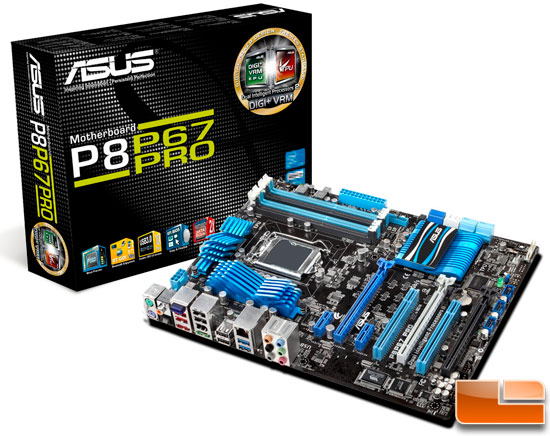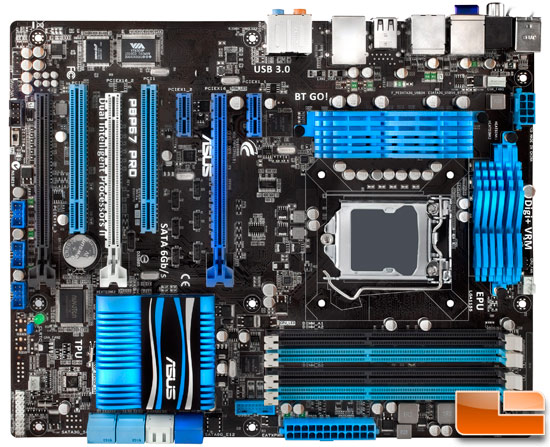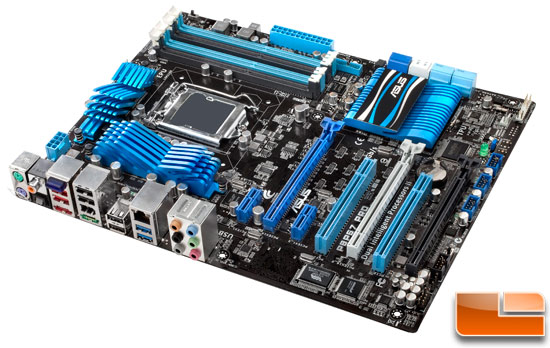ASUS P67 Motherboards – P8P67, Maximus IV Extreme & Sabertooth P67
ASUS P8P67 Pro Motherboard
ASUS has sent over some pictures of their upcoming Intel P67 Express chipset powered motherboards and today we are going to show them to you and give you an idea on what you can expect on the next generation of motherboards. These motherboards are for the upcoming Intel ‘Sandy Bridge’ processors that use a new CPU socket called LGA 1155. The upcoming LGA 1155 socket is rumored to be launching during CES 2011 and has been designed as a replacement for the LGA 1156 socket that came out back in 2009. Intel is said to be working on a number of chipsets for this platform and the ones that we have heard about are the P65 and P67 along with the H65 and H67 and the Q67 and Q65. The P series chipsets don’t support video output while the H and Q series does. Now that we know the very basics of what is coming out here in the next couple of months we feel comfortable showing you some Intel P67 chipset powered boards by ASUS.We have been told that ASUS will have 17 motherboards for this socket at the time of launch. Ten of the boards will be based on the P67 chipset, six on the H67 chipset and one on the Q67.

The first board that we have to show you is the ASUS P8P67 Pro, which is a full size ATX solution. This board sports a black and blue color scheme and as you can see is totally passively cooled without the use of any heat pipes connecting the three blue heatsinks. The entire ASUS LGA1155 motherboard lineup uses a new VRM system that
ASUS calls Digi+ VRM. This means that ASUS is now using digital VRMs on
the boards and that ASUS’ EPU microcontroller handles how many power
phases are in use at any given time by monitoring the temperature and
power draw on the board. We were told by ASUS That Digi+ VRM is able go down to just one power phase or go all the way up to 16 power phases on some of their boards. The ASUS P8P67 Pro has a 12+2 power phase design, so it would only be able to go up to 12 on this specific board. Users of these boards will be able to adjust the load-lone-calibration and even VRM frequency in 10MHz steps, which is a nice touch for advanced users. This is an important new feature for this series of boards and as you can see the retail box of the ASUS P8P67 Pro shows this new feature off on the upper right hand corner.

Looking straight down at the P8P67 Pro you can see that the board has four dual-channel DDR3 memory slots, so while we are sure the board will offer full support of higher frequency memory there is no triple channel memory coming to the mainstream Intel platforms. This board features three PCI x16 slots. From what we understand the primary slot runs at x16 if one video card is used, but if two cards are used it becomes x8 along with the second slot. The third PCIe x16 slot (the black one on the fair left) is presumably x4 and ideal for use with sound cards or maybe a RAID card. Notice that the board has ‘BT GO!’ written on the PCB just above the CPU socket. ASUS says that all of their ATX motherboards of this series will have Bluetooth onboard as a standard feature. One of the reasons for this is that ASUS has designed some new software called BT GO! that will allow you to overclock your system with a Smartphone. Who would have thought a few years ago that we’d be able to overclock our computers at the BIOS level with a Smartphone?
“In regards to BTGO! Your comments in the article correct in that it will offer oc functionality but on the mainstream series that is a very minor add on. The overall focus will be a quick and convenient interface that will be part of AiSuiteII. This interface will allow you to quickly search and connect to you BT enabled phone/device and then transfer/backup files, photos, music, videos etc. There will also be a special contact manager function allowing exporting of contact information from your phone to the OS quickly. This along with a number of special functions will round out the BTGO! software package.” – ASUS PR
In this shot you can also see ‘Dual Intelligent Processors II’ written on the PCB. This is the companies second generation Dual Intelligent Processors design on their motherboards. The first time around the company claimed that the ASUS TurboV Processing Unit (TPU) added up to 37% more performance while the proprietary ASUS Energy Processing Unit (EPU) cut the power drain by up to 80%. It will be interesting to see what changes have been made in their second attempt.

You can’t really tell from the picture above, but the ASUS P8P67 Pro supports two SuperSpeed USB 3.0 headers thanks to an NEC controller, but that might change down the road when better controller designs come out. We have also seen online rumors that these boards will support a new EFI BIOS. This could be one of the biggest changes in more than a decade as an introduction of a more user friendly BIOS interface with mouse support and faster boot times would be nice to have.

The ASUS P8P67 Pro motherboards rear I/O panel doesn’t feature any video outputs because all P67 chipset based boards require discrete graphics. There are a pair of PS/2 ports for a keyboard and mouse, optical S/PDIF out, the Bluetooth transmitter, six USB 2.0 ports, two USB 3.0 ports, IEEE 1394a port, two e-SATA ports,
gigabit Ethernet and finally the eight channel audio connectors.

Comments are closed.